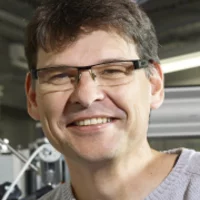The FEMTO group investigates ultrafast (femtosecond to picosecond) dynamics in laser-excited systems using x-rays as a primary tool. The team maintains a laser lab which is used to generate femtosecond x-rays at the MicroXAS beamline via the electron-beam "slicing" technique. In addition to the 100-200 fs time resolution experiments made possible by this method, the team also performs pump-probe laser/x-ray measurements with the natural 70 ps FWHM bunch duration of the SLS.
FEMTO group home page
FEMTO group home page
Status
The femto-slicing source at SLS is operational since summer 2006. Although the current efforts of the team concentrate on the design and construction of a scientific instrument at SwissFEL, the source is currently still being used to perform experiments in collaboration with expert user groups. Research groups interested in a collaboration are encouraged to contact Paul Beaud (paul.beaud@psi.ch) for a discussion on the technical feasibility of the proposed experiment. If possible, try to formulate some answers to this short list of questions to help start this discussion. Experiments with an R&D aspect to the SwissFEL project are prioritized.
Please DO NOT submit a proposal for beamtime using the FEMTO facility without first contacting us and discussing the technical feasibility. This includes any use of the laser system, even if not using the slicing source. This applies even if you have submitted proposals in the past, since the parameters of the facility tend to evolve with time.
Recently, the repetition rate of the source was increased from 1 kHz to 2 kHz. The parameters table below has been updated to reflect this.
Source Parameters
The femtosecond sliced x-rays are generated at the microXAS beamline, at straight 5L of the SLS. Many of the capabilities (e.g. focusing) of this beamline can be carried over to femtosecond operation. The table below lists some of the key properties of the sliced beam.
| Energy range (tuning curves) | 4.2 - 14 keV |
| Flux | 4 x 105 ph/s/0.1% BW (at 5 keV) |
| Bandwidth options (standard) | Full spectrum, 1.3%, 0.045%, 0.015% (other options possible with special optics) |
| Pulse duration (measured) | < 120 fs |
| Repetition rate | 2 kHz |
| Polarization | linear horizontal |
| Energy resolution (with Si(111) monochromator) | 0.02% |
| Halo background (monochromatic, at 6keV) | < 4 x 10-2 |
| Core background (monochromatic, at 6keV) | < 10-3 |
Some definitions of terms
Halo background
The x-rays created by the electrons modulated from previous interactions between the laser and electron beam. The time for one revolution about the SLS is approximately 1 microsecond, and the time it takes for modulated electrons to relax back into the normal electron orbit is several milliseconds. The time structure of these "old" modulated electrons depends on the number of round trips, but ranges from several hundred femtoseconds (after one round trip) to about 70 picoseconds.The background is reported as the ratio of the estimated intensity of the x-rays from the modulated electrons generated by the previous laser pulses to the intensity of the freshly sliced femtosecond pulse, integrated over 10 ns in time.
